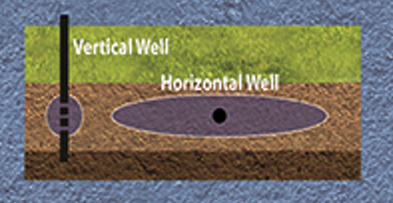The budget is always a critical driving factor for remedial decisions, so let’s talk about money. At a basic level, it is almost always less money to install one vertical well versus one horizontal well; but by which parameters are we making this comparison? From a purely construction standpoint, one vertical well typically contains less material, making it less expensive to install; but how much contact is this providing with the contamination? Horizontal wells are designed to contain 10 to 100s of feet of screen to provide maximum interaction with the target zone. As a result, the remedial effectiveness of one horizontal remediation well is significantly increased compared to one vertical well. Once screen length and contact with the plume are incorporated into the equation, it quickly begins to shift in favor of horizontal wells.
Let’s investigate two situations. The first is a site with a single, confined contaminant hot spot. One vertical well would likely be more cost-effective than one horizontal well and may also provide sufficient remedial performance. What if this situation was reversed? What if the contaminant plume spanned a larger area? One vertical well may cost less, but it will provide minimal remedial effectiveness. Whereas one horizontal well could span most of, if not all of the plume, providing maximum remedial performance. If we compare apples to apples on remedial effectiveness, one horizontal well certainly provides better results. Simultaneously, several vertical wells would be required to remediate a growing plume, favoring horizontal wells from a budgetary standpoint as well.
Time is Money
In remediation, time is money. The longer a system operates, the more money is spent on utility costs for system operation and associated monitoring. Horizontal wells significantly reduce the remedial timeline post-installation because of the increased magnitude of screen contact with the contamination. Particularly on projects where construction costs are comparable, or even favor vertical wells, horizontal wells have proven to reduce the remedial timeline, ultimately saving money in the long run. This pleases both the responsible party and associated innocent businesses affected by the remediation process.
Geology and Navigation
The goal of remediation is to target the preferential pathways that the contamination resides in. More often than not, these geologic zones follow a horizontal layout, creating laterally expansive contaminant plumes. Navigating these zones is another portion of the equation to ensure maximum remediation takes place. By use of horizontal directional drilling techniques, the borehole can be advanced accurately within the target zone. Various locating services for the drill bit are implemented to control adjustments in the x, y, and z directions. By moving parallel within the zone, allows upwards of several hundred feet of screen contact with the plume. The alternative, vertical technique intercepts the target zone at a perpendicular orientation, reducing screen contact with the target geologic layer.
Though it may be true that the installation of one vertical well is less expensive when compared to one horizontal well, there are many parameters to consider when balancing that scale. Plume size, screen contact, and navigation within preferential pathways are just a few factors to consider, which can quickly make horizontal remediation wells a more lucrative option.
How can the advantages offered by decades of technological advancement in the field of horizontal wells benefit your project? Call our horizontal remediation well experts at 1-877-788-4479 to discuss your current project needs or email us at drilling@directionaltech.com with questions, review case studies, and learn more.
Written by: Elliott Andelman, Professional Geologist
